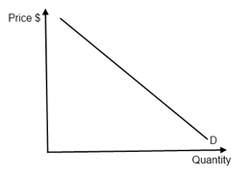Every business owner’s goal is to be successful. However, before one even begins to dream about success, it is paramount that he/she understands the rules of the marketplace and how it operates.

With that established, the first rule that everyone must fully grasp is the law of demand. Put simply, the law of demand states that the quantity of a good demanded falls as the price rises, and the quantity of a good demanded rises as the price falls. Pretty simple right? Well this simple law actually has many hidden elements behind it that one might not immediately notice. Below is a list of just a few of the many factors that might affect demand.
Number of Potential Buyers
This can seem to be the most obvious impact of the demand curve, but can also be surprisingly complicated in its own right. It might seem self explanatory that an expansion in the number of potential buyers for a product increases the demand for a product, thus raising the overall price of the product. This is why we see cities with large populations such as Chicago, New York, and Los Angeles rise up as hubs of entrepreneurship. However, one has to be careful as there are underlying factors one might not notice at first glance.
When creating a product one must be careful of not just looking at overall population density/size, but also that they are appealing to the right demographic. For example, if you were to open a candy store in the middle of a hospital it would not garner much interest. On the other hand, if you were to set up a partnership with the hospital to sell life insurance to patients, that would definitely be more profitable.
Household Income
Another thing one must consider is the average household income of their user. Of course, the most obvious thing to assume is that usually when income rises, people buy more of good X. However, this only the case for something called “normal goods”. There are also a type of good called inferior goods which means that when average household income goes up, then you are likely to purchase less of it. Sound strange? It might make more sense to take fast food into consideration here. Most likely, a low income family would eat fast food often, as it is cheap, quick and easily accessible. However, as you shift from low income families to middle/upper level income, it is easy to see that these middle/upper level families purchase substantially less fast food overall. This means that things such as the Big Mac are inferior goods. This can also be applied to things such as health insurance (as people start to get wealthy they might not need the insurance anymore). One should take into account not only the average household income of their use will be, but also what will happen if the average income rises or falls.
Price and Availability of Related Goods
Often times people will price their goods without taking into account the availability substitutes. A substitute is a good similar enough where people are willing to purchase good X over Y if good Y increases in price. Things such as Coca Cola and Pepsi are good examples of substitutes. Generally speaking, the two are priced the same at the supermarket. Yet, if Pepsi wanted to attempt to increase profits by raising its price 10 cents per 12-pack, many more people would lean towards buying Coke while shopping, causing an overall loss of revenue. When attempting to create or develop a good, it is important to note just how much the competitors are charging in order to make sure that your business sets a good price. However, it is also important to note that if one were to tweak a product enough so that it is not a substitute anymore, then it is possible to raise the price more without too much effect on profit, increasing overall revenue.
Expectations
Overall, the most important trait that a business can have is to be aware of its surroundings. Understand the target demographic that you are selling too. Realize what kind of good your product is. Research all potential substitutes. In the end, you are your own best competitor as you try to improve your business and reach your goals.